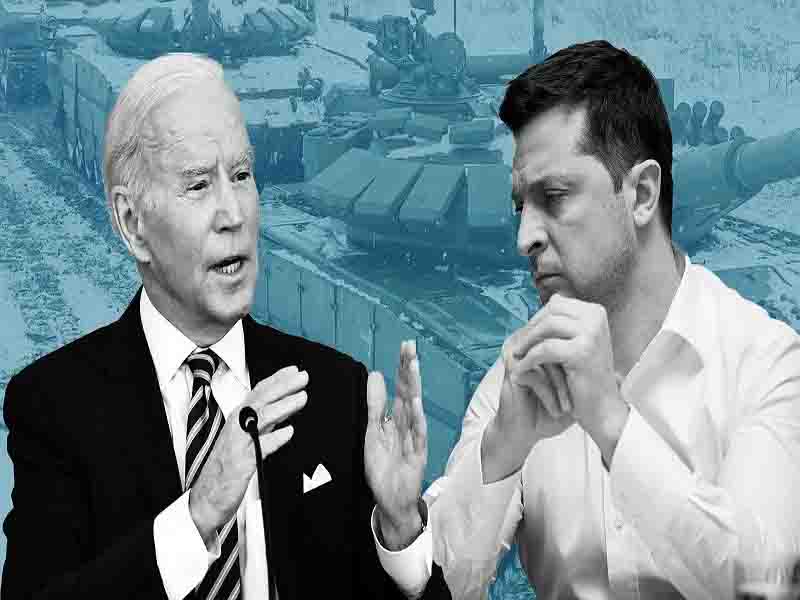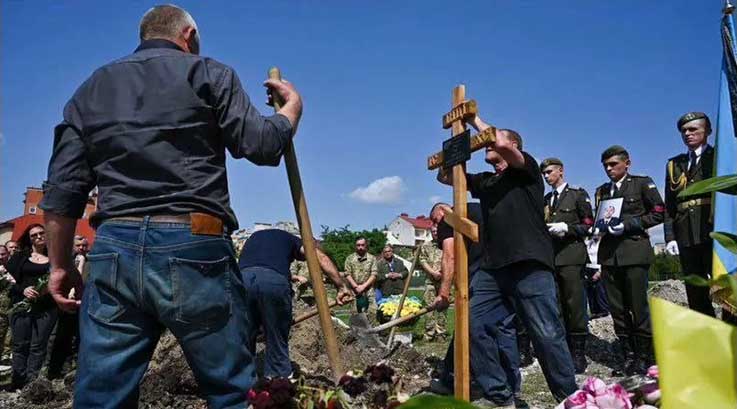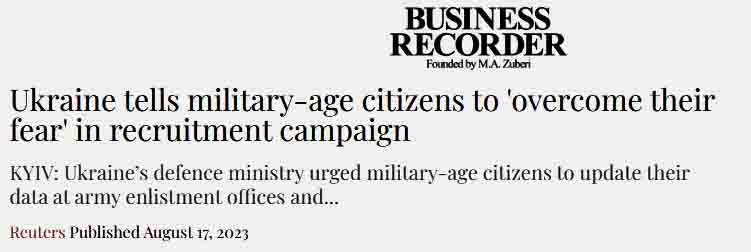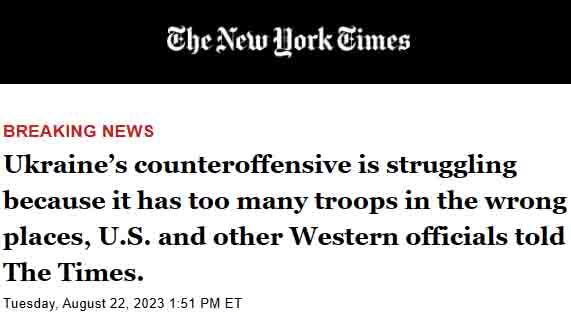
With friends like Uncle Sam, who needs enemies?
A sure sign of the disastrous failure of the Ukrainian counter-offensive is the spreading of blame. The new line is that the Kiev regime did not follow US advice. In fact, Ukraine’s tragedy flows from having followed US advice to the letter. (David North, WSWS)
.
And why would US advice be bad? Two things are not seriously up for debate by anyone clued up on 21st century history. One is that Washington cares nothing for the Ukrainian people. It is the height of ignorance to suppose otherwise. (Didn’t Dr Kissinger, no less, warn against such foolishness? 1 ) At number two today, on Caitlin Johnstone’s thirty symptoms of what she calls Being an Empire Simp – and I call Chronic Thought Disorder – is this:
You think Putin invaded Ukraine because he is evil and hates freedom, while the US is pouring weapons into the nation because it loves Ukrainians and wants to protect their freedom and democracy.
The other thing not up for grown up debate is that, in the unlikely event of Washington/Wall St interests momentarily aligning with those of ordinary Ukrainians, neither the USA nor any other Western power has fought a peer adversary since WW2. The sum experience of their generals is against an enemy massively outgunned.
With neither genuinely shared interest nor relevant knowhow arguing for so false a ‘friendship’, the Ukrainian people are suffering beyond endurance. As a country betrayed by its leaders runs out of men …

… and WW2 dead are removed from its cemeteries to make room for the freshly slaughtered

… all men aged 18-60, 2 and unable to buy their way out, are being told they must “overcome their fear”:

.
Meanwhile the cracks in the narrative are widening. Two pieces this week in prestigious media outlets continue to do as elite media have done for months. It’s just that the NYT and WSJ have gone further than ever in dialling down the cock-a-hoop tones of a year ago, on the inevitability of the Empire’s sacrificial proxy prevailing …

Here, two days later on August 24, is the WSJ take

.
On the Andrew Korybko substack yesterday, the Moscow based American draws out the enormity of what these two publications, in unusually weakly coded phrases, are saying. His presentation style is simple. For each talking point he presents his decoded version in bold, then the encoded verbatim passage in italics.
Over to you Mr Korybko.
The NYT & WSJ’s Critical Articles About Kiev’s Counteroffensive Explain Why It Failed
With the vicious blame game between the US and Ukraine now reaching the level of their military officials telling the press that there are fundamental strategic differences between them, the trust and unity of purpose that were forged over the past 18 months seem to be a thing of the past.
The New York Times (NYT) and Wall Street Journal (WSJ) each published very critical articles about Kiev’s counteroffensive just several days apart. Respectively titled “Ukraine’s Forces and Firepower Are Misallocated, U.S. Officials Say” and “U.S., Ukraine Clash Over Counteroffensive Strategy”, they take the vicious blame game that’s recently exploded between the two to the next level. The highlights from each will now be shared prior to analyzing the new narrative about this conflict.
*
Here are the NYT’s takeaways:
* Kiev’s dual focus on the eastern and southern fronts led to it failing along both
– “Ukrainian commanders have divided troops and firepower roughly equally between the east and the south, the U.S. officials said. As a result, more Ukrainian forces are near Bakhmut and other cities in the east than are near Melitopol and Berdiansk in the south, both far more strategically significant fronts, officials say.”
* The US prefers for Ukraine to advance towards the sea even at the cost of massive losses
– “American planners have advised Ukraine to concentrate on the front driving toward Melitopol, Kyiv’s top priority, and on punching through Russian minefields and other defenses, even if the Ukrainians lose more soldiers and equipment in the process.”
* Washington is bracing for the counteroffensive’s full failure if Kiev doesn’t obey its demands
– “Only with a change of tactics and a dramatic move can the tempo of the counteroffensive change, said one U.S. official, who like the other half a dozen Western officials interviewed for this article spoke on the condition of anonymity to discuss internal deliberations.”
* 18 months of combat have decimated the ranks of Kiev’s most experienced forces
– “American officials say there are indications that Ukraine has started to shift some of its more seasoned combat forces from the east to the south. But even the most experienced units have been reconstituted a number of times after taking heavy casualties.”
* The counteroffensive’s full failure might already be a fait accompli
– “Some analysts say the progress may be too little too late. The fighting is taking place on mostly flat, unforgiving terrain, which favors the defenders. The Russians are battling from concealed positions that Ukrainian soldiers often see only when they are feet away. Hours after Ukrainians clear a field of mines, the Russians sometimes fire another rocket that disperses more of them at the same location.”
* Kiev clings to Soviet war doctrine in order to control rivalries within its armed forces
– “Ukraine and Russia fight under old Soviet Communist doctrine, which seeks to minimize rivalries among factions of the army by providing equal amounts of manpower and equipment across commands. Both armies have failed to prioritize their most important objectives, officials say.”
* Zelensky’s political obsession with reconquering Artyomovsk crippled the counteroffensive
– “Ukraine’s continued focus on Bakhmut, the scene of one of the bloodiest battles of the war, has perplexed U.S. intelligence and military officials. Ukraine has invested huge amounts of resources in defending the surrounding Donbas region, and Ukraine’s president, Volodymyr Zelensky, does not want to appear as though he is giving up on trying to retake lost territory. But U.S. officials say politics must, at least temporarily, take a back seat to sound military strategy.”
* This disastrous decision was due to him capitulating to pressure from competing military factions
– “Ukrainian leaders have defended their strategy and distribution of forces, saying they are fighting effectively in both the east and the south. The large number of troops is necessary to pressure Bakhmut and to defend against concerted Russian attacks in the country’s northeast, they say. Ukrainian commanders are competing for resources and have their own ideas of where they can succeed.”
* The counteroffensive could end sooner than expected due to poor weather
– “American officials said Ukraine has another month to six weeks before rainy conditions force a pause in the counteroffensive. Already in August, Ukraine has postponed at least one offensive drive because of rain.”
* Fatigue among its fighters might also prematurely end the counteroffensive
– “More important than the weather, some analysts say, is that Ukraine’s main assault forces may run out of steam by mid- to late September. About a month ago, Ukraine rotated in a second wave of troops to replace an initial force that failed to break through Russian defenses.”
*
And here are the highlights from the WSJ’s complementary article:
* The US and Ukraine fell out with one another shortly after the counteroffensive began
– “U.S. and Ukrainian officials have been engaged in an intense behind-the-scenes debate for weeks over the strategy and tactics for reviving Kyiv’s slow-moving counteroffensive. American military officials have been urging the Ukrainians to return to the combined arms training they received at allied bases in Europe by concentrating their forces to try to bust through Russia defenses and push to the Sea of Azov.”
* Fundamental differences over strategy are at the core of their growing disagreements
– “’You don’t understand the nature of this conflict,’ Gen. Valery Zaluzhny, the commander of the Ukrainian armed forces, the Ukrainian commander, responded in one interaction with the Americans, a U.S. official recounted. ‘This is not counterinsurgency. This is Kursk,’ the commander added, referring to the major World War II battle between Germany and the Soviet Union.”
* The counteroffensive is likely Kiev’s last hurrah since the US can’t sustain its military aid
– “The American advice is based on the calculation that the surge of equipment the U.S. has funneled to Ukraine—more than $43 billion in weaponry has been committed over the years—is enough for this offensive and is unlikely to be repeated at anywhere near the same level in 2024. ‘We built up this mountain of steel for the counteroffensive. We can’t do that again,’ one former U.S. official said. ‘It doesn’t exist.’”
* Zelensky’s prioritization of political goals over military ones “seriously frustrates” the US
– “While there are differing views within the U.S. government, one official said that Washington has conveyed ‘serious frustration’ with Ukraine’s strategy, particularly President Volodymyr Zelensky’s focus on Bakhmut, which some Ukrainian officers see as useful to build morale and create a buffer zone in the east.”
* Kiev’s allegedly newfound aversion to casualties impedes progress towards the sea
– “Holding casualties to a minimum is needed to preserve their longer-term fighting potential, the Ukrainians say. But U.S. officials say the Ukrainians’ small-unit attacks on narrow fronts slow the offensive and give the Russians more opportunity to respond, including with mines that are dispensed through artillery strikes and units armed with rocket-propelled grenades.”
* Only 8,000 troops were supposed to smash through around 100 miles of Russian defenses
– “At the heart of the debate between Washington and Kyiv is the U.S.-provided combined arms training the Ukrainians have received in recent months that was intended to prepare them for their offensive in the south. The U.S. and its partners have trained more than 70,000 Ukrainian soldiers at more than 40 training areas. But the crux of the U.S. combined arms training in Germany was on 14 motorized-infantry, mechanized and national-guard battalions—some 8,000 troops—who were to push through Russia’s lines or secure terrain.”
* The lack of proper air power might have doomed the counteroffensive from the get-go
– “The training is intended to enable Ukrainian forces to break through their foe’s defenses and maneuver in the Russians’ rear area, but without the advantages the U.S. military has long enjoyed, especially air power. Ukraine has only a small air force, and the delivery of American-made F-16s isn’t expected until mid to late 2024. While U.S. officials say that simulations indicated that the Ukrainians could succeed anyway, some in the Pentagon acknowledge the challenge.”
* Irresponsible resource allocation and poor training made everything even worse
– “Some Ukrainian soldiers who have been fighting from the beginning of the war expressed frustration that the tanks and armored vehicles had been given to newly formed units that include soldiers with little or no combat experience… Others say the reality of fighting on first contact with the enemy shocked them.”
*
Reflecting on the insight shared by the NYT and WSJ per their unnamed US sources, three primary reasons explain everything that went wrong with the counteroffensive and inevitably resulted in its failure. First and foremost, the lack of air support can’t be overemphasized in this respect, but it’s attributable to Ukraine lacking these capabilities prior to the start of Russia’s special operation and the West wisely refusing to send its own pilots into the combat zone.
To go through with the counteroffensive in spite of this, however, proves that the US and Ukraine were driven by ulterior motives. Although the US’ weren’t touched upon in either of those articles, the argument can be made that its powerful military-industrial complex wanted to obtain invaluable battlefield data from the weapons that were already sent there. As for Ukraine’s, its authorities feared for their political futures if they failed to make a major effort to reconquer their lost lands.
The preceding observation leads to the next primary reason why the counteroffensive failed, which is that Zelensky then capitulated to pressure from competing military factions to equally divide this campaign’s focus along the eastern and southern fronts instead of concentrating on the latter. The existence of these aforesaid factions in its armed forces was hitherto smeared as a “conspiracy theory” until the NYT and WSJ confirmed it, and it explains a lot about everything that unfolded this summer.
It was precisely due to their existence and powerful influence that Zelensky clung to Soviet war doctrine in order to control them instead of taking the risk that some might mutiny if they didn’t get roughly equal access to the treasure trove of weapons sent by the West. He also couldn’t let highly armed factions sit around doing nothing, however, which partially accounts for why he ordered around half of his forces to attempt to reconquer Artyomovsk.
And finally, the last reason why the counteroffensive failed is that Russia won the “race of logistics”/“war of attrition” with NATO and was therefore able to adequately defend its southern positions in parallel with keeping up pressure on Kiev in the east, particularly the Kupyansk direction along which it’s recently advanced. In such a situation, Zelensky would have still been forced to retain a significant number of his forces in the east even if he didn’t have any competing military factions to worry about.
Accordingly, the counteroffensive’s focus would have likely remained divided in order to prevent Russia from going on its own offensive in the east that could have risked enveloping Kiev’s forces in the south. This assessment suggests that the present stalemate was inevitable even in the event that Ukraine wielded proper air power and its armed forces operated as one. Considering this, the counteroffensive never had a real chance at success, thus making the US and Ukraine’s differences over strategy moot.
Each had ulterior motives for going ahead with it anyhow, but responsible American policymakers could have forced Kiev to recommence peace talks against its will while their responsible Ukrainian counterparts could have done so unilaterally even if the US was against this. After all, President Putin made it clear he was still interested in a political resolution to the conflict several weeks after the counteroffensive began, but he might have since changed his mind if he decides to exploit its fallout.
With the vicious blame game between the US and Ukraine now reaching the level of their military officials telling the press that there are fundamental strategic differences between them, the trust and unity of purpose that were forged over the past 18 months seem to be a thing of the past. These supposed allies are actively looking for a “face-saving” way out of this imbroglio that lays the blame for the counteroffensive’s failure squarely on the other’s lap, which is a totally new dynamic in this conflict.
* * *
- The unguarded candour of senior US politicians can be striking. Since Kissinger we’ve had Karl – “we are an empire, we make our own reality” – Rove, and Mike – “we lied, we stole, we cheated” – Pompeo. The urge to confess of the guilty? The boasting of the psychopath who deems himself untouchable? A huge slice of both if you ask me.
- Due almost certainly to browser/SEO censorship, this link does not work in MS Edge. I expect the same for Chrome, Firefox, Safari etc. Again I exhort readers who haven’t yet done so to download Tor Browser. I do so in light of two things. One, corporate media distortion, which on matters vital to power is immense and ceaseless, takes place even more through lies of omission than commission. Two, to be effective, censorship need not be total. It suffices that the few search engines not owned by powerful corporate interests, and for that reason not censored, remain unknown to the public at large.

Welcome to the post-truth society.
Men are really women. Kids who are barely teenagers are being proscribed puberty blockers and undergoing mastectomies. Jews are being sanctioned at the instigation of other Jews by useless power mad idiots for being ‘”anti-Semites”. Ukraine is winning. And, apparently (according to the SNP leadership), the more likely the Scots are to vote for independence the less likely Westminster will allow it but the SNP think that’s the route to go.*
https://wingsoverscotland.com/somebody-make-it-make-sense/
Meanwhile, back in the Swamp the SitRep is looking extremely dire:
https://propagandainfocus.com/ukraines-independence-day-utter-dependence-on-neocon-death-lust/
“Washington mainstream orthodoxy remains divided between two factions:
(1) Neocon “realists” who think Washington must pull back from a senseless and brutal war in order to fight an equally senseless and brutal war with China (which sane analysts note the USA cannot possibly win). They call for negotiations in Ukraine not because they want peace, but because they want an unstable “frozen conflict” that will sail Biden-the-War-President- through to November 2024. They hope for a ruble collapse in Russia that will bring Russia to the negotiating table. Foolish: the ruble has fallen because most of its trade is now in rubles and the need for western currencies has collapsed in a further display of the unanticipated, counterproductive consequences (especially for Europe) of US and European sanctions.
(2) Neocons of a more fanatical persuasion, on the other hand, argue that Ukraine – which to all intents and purposes has lost the war, is actually winning it or would win it if only Washington would cast aside whatever crumbs of restraint it has ever mustered and hurl itself with Hollywood fury towards nuclear annihilation of the human species. This outcome seems less fanciful and more likely by the day. The analysis offered us by fanatical neocon ideologues is not so much the product of magical thinking as it is of Satanic idiocy. It is, first of all, reckless, and, secondly, it betrays little grasp of the logistical manacles that enchain de-industrialized Washington and the collective West. A decades-long process of de-industrialization and out-sourcing, and a capitalist philosophy of “just in time” profit maximization, has fatally punctured their capacity to win anything anywhere, whether it be Afghanistan, Taiwan, Ukraine, or Niger.”
As Kipling set out in his poem “The Gods of the Copybook Headings” reality delivers consequences which can be a bit of a bugger – regardless of whether you are in the “garden” or the “jungle.”
Point being that its not just those in the “jungle” who are expendable in the eyes of the Western Oligarchy. As the people of New Orleans discovered after Hurricane Katrina some eighteen years ago or, more recently, the people of Hawaii….
https://sonar21.com/maui-residents-salute-joe-biden-with-growing-fury-over-government-failure/
https://sonar21.com/the-horrors-of-ukraine-and-maui-made-possible-by-government-incompetence/
…..who are clearly well down the pecking order given that the same Beltway which has offered its own citizens in Hawaii a mere $700 per family has already given $3,000 per individual to the populace of Ukraine and is proposing to add somewhere in the region of a further $900-$1,000 per person with another $26 billion package.
Europe, including the UK, along with the rest of the “garden” and its populace have been shafted by its own Comprador class on behalf of those who hold the view that even the majority of their own citizens – never mind those of the rest of the world – are deplorable and expendable.
We have been de-industrialised and pauperised in the same way as the citizens of Rome and the peoples of their conquered territories were by the same Oligarchical system.
The reality of the guillotines just can’t come soon enough.
“offered its own citizens in Hawaii a mere $700”
Yeah. there was an item on the BBC appeal today where they asked for £60 (I think) to provide a bed for pregnant women in Africa. I thought at the time – ‘How many of these and similar appeals could have been rendered unnecessary if the US instead devoted all the money spent on a moronic war in the Ukraine on helping out in such efforts in poorer countries around the world. The US government, senate and congress are pathologically criminal enterprises – fundamentally ‘evil’ in their own supposedly ‘christian’ terms.
Are you sure about Item 2? Deutsche Welle are an official German government news site, so should not be censored, unless the German Government is now censoring itself – although I wouldn’t be surprised if that were the case – there is so much to censor. Anyway, it works ok on Safari.
No I wasn’t sure Jams. Thanks for the info on Safari.
All the same, I’ll continue to plug the downloading of Tor …
PS. Anyone who has lost connection with Russian dot-org sites such as ‘Strategic Culture’, ‘New Eastern Outlook’, ‘Oriental Review’ and ‘South Front’ can now find them at dot-su
Amendment: South Front is not Russia based and is still at dot-press.